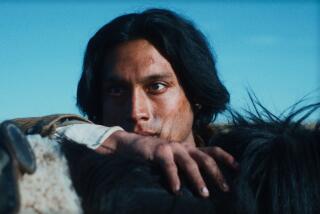In ‘Apocalypto,’ fact and fiction play hide and seek
A key consultant among several archeologists who served as advisors on Mel Gibson’s “Apocalypto” said he is disappointed that the film overlooks many of the Mayas’ cultural and scientific achievements and portrays the people as “bloodthirsty savages.”
As a chase movie, “Apocalypto” is top-notch, said Richard D. Hansen, a professor of anthropology at Idaho State University who has written extensively about the Mayas. The sets, makeup and costumes are also “accurate to the nth degree,” he noted. But it’s a feature film -- not a documentary -- which may let down those looking for accuracy at every turn.
“This is Hollywood, first and foremost,” Hansen said.
As with any historically based feature, whether it’s “Alexander” or “All the President’s Men,” directors take creative license with the facts. “Apocalypto” is no different.
“The final decision when making a film is, ‘What is the right balance between historical authenticity and making it exciting, visually as well?’ ” said Farhad Safinia, who cowrote the script with Gibson, adding: “The film is an all out entertainment thrill ride, and that is what it was always designed to do. It is a work of fiction.”
Gibson and Safinia have said they wanted the film to serve as a reminder to today’s world that the precursor to the fall of a civilization is always the same: widespread environmental degradation, excessive consumption and political corruption.
But archeologists point out that nobody knows why the Mayas, who ruled in the Americas for more than 1,000 years, abandoned their cities and allowed their majestic pyramids to become overgrown with jungle. And to watch Gibson’s “Apocalypto,” one might not realize that the Mayas were in fact a highly sophisticated people: They mapped celestial objects, developed an accurate 365-day calendar, created their own writing system and perhaps most notably had developed the concept of zero in mathematics.
“The calendar [angle] is so rich,” Hansen said. “It would have been a marvelous part of the story.”
Safinia said that the film’s narrative is told through the eyes of the central protagonist, Jaguar Paw, and it is his journey that we follow. “You do see aspects of the Mayan civilization in the background,” Safinia said, such as their architecture, their industry and their preponderance to ornament themselves with jewelry, costumes, textiles and such.
Gibson’s long-awaited film, which opened Friday to mixed reviews and criticism of its scenes of excessive violence, re-creates with great effect the bloody drama of human sacrifice that took place atop a Maya pyramid.
In one memorable scene, a Maya priest slashes open the chests of frightened prisoners, rips out their still-beating hearts and decapitates them. All the while, the populace screams and gesticulates wildly as each severed head comes bouncing down the steps.
Experts say that although the Mayas did practice human sacrifice, it came late to their civilization and was likely picked up from the Aztecs.
The movie “makes us think that maybe [the Maya] were bloodthirsty savages,” Hansen said.
Safinia says that reality was far more intense than the film shows. “The Mayans did engage in decapitation. They did roll bodies down the temple steps,” he said, noting there is evidence that the crowds tore the bodies apart limb by limb, but “you can’t show that stuff” on screen.
The film’s hero, played by actor Rudy Youngblood, is a forest dweller who is taken prisoner by a Maya raiding party. Later, he and other captives are given a chance to run for their lives in a deadly game in which Maya warriors throw spears and fire arrows at them for sport.
Hansen and Safinia can’t say for certain that such a game ever existed among the Mayas.
“The process of using these individuals as target practice is a real possibility,” Hansen said. “I couldn’t say it did happen, but I couldn’t say it didn’t either. [Gibson] wanted to have some reason to have the guys go after Rudy Youngblood, to go after the hero....That was entirely Mel’s scenario -- but it’s highly reasonable.”
Some question why Gibson included that scene instead of a sport for which the Mayas are truly famous: ball games.
Jim Brady, who teaches archeology at Cal State L.A., said he has never heard of the Mayas staging a target practice game with prisoners, but they certainly staged sporting events on ball courts using rubber balls and stone rings. Brady, who has not seen the film, noted that there are indications that the captain of the losing team may have been sacrificed, “but we don’t know how much that happened.”
In the film, Jaguar Paw and other prisoners appear awed by the grandeur of the pyramids as they are led into the Maya city to meet their fate.
But Brady notes that anyone living in that region certainly would have been aware of pyramids.
In another much talked-about scene, Jaguar Paw comes upon a giant pit filled with hundreds of sacrificial bodies.
Hansen said it is “conjecture” whether those pits existed. “All [Gibson was] trying to do there is express the horror of it.”
“Apocalypto” depicts the latter days -- the post-classic period -- of Maya civilization, but the main pyramid where the human sacrifices occurred actually comes from classic period, when the Mayas were at their zenith. “There was nothing in the post-classic period that would match the size and majesty of that pyramid in the film,” Hansen said. “But Gibson was trying to make a story here. He was trying to depict opulence, wealth, consumption of resources.”
Safinia said the mixing of architectures was done for aesthetic reasons.
About 25 members of the Maya community in Los Angeles were invited to an advance screening of Gibson’s film last week. Two of those who attended came away impressed, but added that they too wished Gibson had shown more of the Maya civilization.
“It was a great action film that kept me on the edge of my seat,” said Sara Zapata Mijares, president and founder of Federacion de Clubes Yucatecos-USA. “I think it should have had a little bit more of the culture,” such as the pyramids. “It could have shown a little more why these buildings were built.”
Still, she said, it was a “great picture.”
Alfonso Escalante, who teaches folk dancing, said the movie was “very exciting” and the costumes were stunning, but for people who don’t know anything about the Maya culture, “It’s going to be a little tough because there was more about killing than about the culture. But definitely, they are going to see how they looked at that time, how they lived.”
*
More to Read
Only good movies
Get the Indie Focus newsletter, Mark Olsen's weekly guide to the world of cinema.
You may occasionally receive promotional content from the Los Angeles Times.










